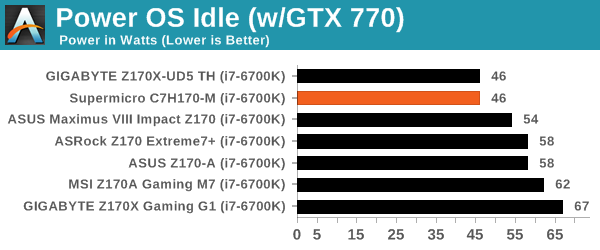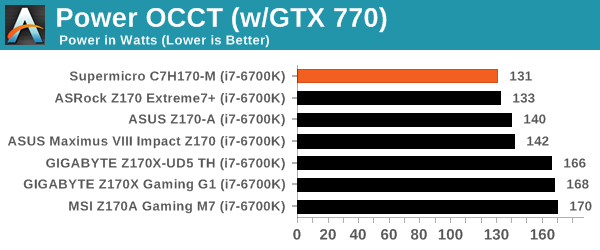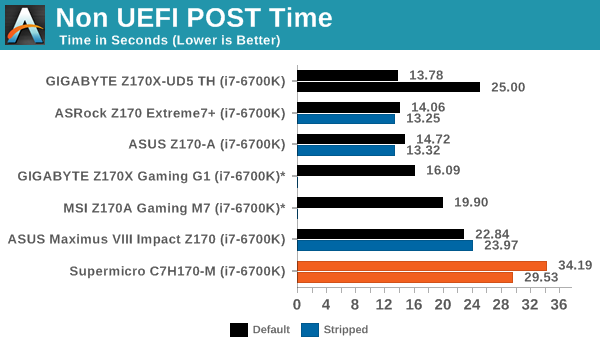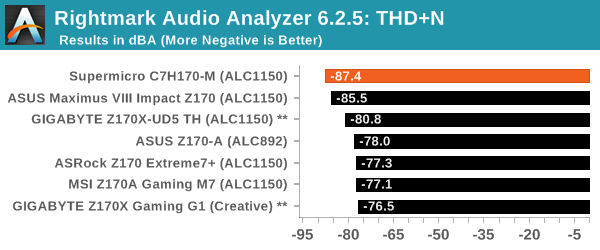Why an Overclockable Core i3 Might Not Exist: The Supermicro C7H170-M and Intel Core i3-6100TE Review
by Ian Cutress on March 17, 2016 10:30 AM EST- Posted in
- CPUs
- Intel
- Motherboards
- Core i3
- Supermicro
- Overclocking
System Performance
Not all motherboards are created equal. On the face of it, they should all perform the same and differ only in the functionality they provide - however this is not the case. The obvious pointers are power consumption, but also the ability for the manufacturer to optimize USB speed, audio quality (based on audio codec), POST time and latency. This can come down to manufacturing process and prowess, so these are tested.
Power Consumption
Power consumption was tested on the system while in a single MSI GTX 770 Lightning GPU configuration with a wall meter connected to the OCZ 1250W power supply. This power supply is Gold rated, and as I am in the UK on a 230-240 V supply, leads to ~75% efficiency > 50W, and 90%+ efficiency at 250W, suitable for both idle and multi-GPU loading. This method of power reading allows us to compare the power management of the UEFI and the board to supply components with power under load, and includes typical PSU losses due to efficiency. These are the real world values that consumers may expect from a typical system (minus the monitor) using this motherboard.
While this method for power measurement may not be ideal, and you feel these numbers are not representative due to the high wattage power supply being used (we use the same PSU to remain consistent over a series of reviews, and the fact that some boards on our test bed get tested with three or four high powered GPUs), the important point to take away is the relationship between the numbers. These boards are all under the same conditions, and thus the differences between them should be easy to spot.



The C7H170-M pulled in some good low numbers for idling and load, which should be expected for a smaller motherboard without too many controllers. The power delta from long idle to load was 86W, which is one of the best of all the 100-series systems we’ve tested.
Non UEFI POST Time
Different motherboards have different POST sequences before an operating system is initialized. A lot of this is dependent on the board itself, and POST boot time is determined by the controllers on board (and the sequence of how those extras are organized). As part of our testing, we look at the POST Boot Time using a stopwatch. This is the time from pressing the ON button on the computer to when Windows 7 starts loading. (We discount Windows loading as it is highly variable given Windows specific features.)

One drawback of systems outside of the normal big four vendors has historically been POST times, and the C7H170-M continues this trend, being over 30 seconds from power on to seeing Windows 7 being loaded. Cutting out the audio and network controllers for a stripped POST time reduced it to just under 30 seconds, but that is still twice as long as the best 100-series motherboards.
Rightmark Audio Analyzer 6.2.5
Rightmark:AA indicates how well the sound system is built and isolated from electrical interference (either internally or externally). For this test we connect the Line Out to the Line In using a short six inch 3.5mm to 3.5mm high-quality jack, turn the OS speaker volume to 100%, and run the Rightmark default test suite at 192 kHz, 24-bit. The OS is tuned to 192 kHz/24-bit input and output, and the Line-In volume is adjusted until we have the best RMAA value in the mini-pretest. We look specifically at the Dynamic Range of the audio codec used on board, as well as the Total Harmonic Distortion + Noise.


Using the ALC1150 codec means that the C7H170-M should have some potential, although the board comes without most of the enhancements we typically see with souped up versions of the codec. Perhaps surprisingly we get the best THD+N result out of any codec we’ve ever tested on 100-series motherboards.
USB Backup
For this benchmark, we transfer a set size of files from the SSD to the USB drive using DiskBench, which monitors the time taken to transfer. The files transferred are a 1.52 GB set of 2867 files across 320 folders – 95% of these files are small typical website files, and the rest (90% of the size) are small 30 second HD videos. In an update to pre-Z87 testing, we also run MaxCPU to load up one of the threads during the test which improves general performance up to 15% by causing all the internal pathways to run at full speed.
Due to the introduction of USB 3.1, as of June 2015 we are adjusting our test to use a dual mSATA USB 3.1 Type-C device which should be capable of saturating both USB 3.0 and USB 3.1 connections. We still use the same data set as before, but now use the new device. Results are shown as seconds taken to complete the data transfer.

Using the default Intel drivers, the USB 3.0 ports for the C7H170-M gave our worst result so far. This may be down to some BIOS tuning which the other motherboard manufacturers have been doing for many years.
DPC Latency
Deferred Procedure Call latency is a way in which Windows handles interrupt servicing. In order to wait for a processor to acknowledge the request, the system will queue all interrupt requests by priority. Critical interrupts will be handled as soon as possible, whereas lesser priority requests such as audio will be further down the line. If the audio device requires data, it will have to wait until the request is processed before the buffer is filled.
If the device drivers of higher priority components in a system are poorly implemented, this can cause delays in request scheduling and process time. This can lead to an empty audio buffer and characteristic audible pauses, pops and clicks. The DPC latency checker measures how much time is taken processing DPCs from driver invocation. The lower the value will result in better audio transfer at smaller buffer sizes. Results are measured in microseconds.

DPC Latency is still an odd discussion point on 100-series. We’ve seen ASUS get it right, MSI not too far behind but the others are playing catchup.










62 Comments
View All Comments
nathanddrews - Thursday, March 17, 2016 - link
Predicating the value of i3 overclocking as a whole on the 6100TE is absurd, don't you think? The 35% OC of the 6100TE is still slower than the base clock speed of the vanilla 6100 (3.7GHz), which when OCed over 4.2GHz offers a tremendous value. For the same price - why on earth would you buy the much slower 35W variant if your goal is overclocking?http://ark.intel.com/compare/90729,88181
From the standpoint of motherboard/BIOS SKYOC availability alone I would agree that the case is now somewhat moot, but I think the case that has already been made months ago by DigitalFoundry and others is that the SKYOC i3 (normal i3 CPUs that you can buy) makes a very strong value. It's a shame that mobo vendors caved so quickly.
dualsmp - Thursday, March 17, 2016 - link
I suspect politics is a work here. Also, the conclusion would be more clear cut with the 6100 rather than a bit nebulous with the 6100TE.Remember how fast Intel shutdown overclocking after the Clarkdale i3? When the Clarkdale i3 was overclocked it was nipping at the heels of Intel's more expensive parts at the time. The Clarkdale i3 offered too much value for the money when overclocked, so Intel had to shut it down.
ImSpartacus - Thursday, March 17, 2016 - link
You're probably right about the politics. It's a shame, but Anandtech is probably under Intel's finger.alistair.brogan - Thursday, March 17, 2016 - link
Is there hope for an AMD Zen dual core that will overclock? That's all I'd recommend for people :)ImSpartacus - Friday, March 18, 2016 - link
If zen is only 40% better ipc than excavator, then it won't be leading Intel and amd will still need high clocks compete. So I would bet that the stock zen parts might be using up a fair bit of that overclocking headroom.alistair.brogan - Thursday, March 17, 2016 - link
I think a properly overclockable i3 would hit 4.5ghz, just like an i5 can, so imagine the results in that case. It wouldn't "maybe" be worth it, it would absolutely by awesome. Which is why Intel doesn't allow it..... don't want people buying 4.5ghz i3's and saying good bye to the expensive i5sdragosmp - Thursday, March 17, 2016 - link
Thanks for the review, it's a good reference point.I thought at some point the lowest end Xeon v5 (4C/8T) was quite a bit cheaper than the 6700K and much more available. If that could be OCed, and I think some motherboards like Gigabyte's Cxxx say they could, that would have been the fastest CPU while keeping some money in the pocket.
Agreed with getting older and putting a higher value on our time, but if my kid decides to leave me alone for a while I still like to tinker with OCing
Samus - Friday, March 18, 2016 - link
It's true Xeon's are usually priced between the i-series and i-series k equivalents (there are i5 and i7 based Xeon's) so it would be cheaper than a "k" part while giving you ECC and full vPro support, not to mention Xeon's appear to have soldered heatspreaders when starting with Ivy Bridge, everything but Xeon's were shipped with pretty subpar TIM/paste. That only slightly improved with Devils Canyon...they still weren't fused lid-to-die like a Xeon.There are a few theories why Intel uses solder on Xeon CPU's. One is obviously temperature and 24/7 consistency. The most plausible reason, though, is the weight and pressure of server cooling solutions (compared to most OEM PC coolers and water blocks. I weighed a tiny 1U Xeon cooler once. This thing was like 20mm tall, and it still weighed 870 grams. That's 2 lbs! Pure block of copper fins. Tightened down to 25Nm and exposed to the pressure, vibration and temperatures of a 1U environment for years, you can take a guess why Intel makes the Xeon lids more durable.
extide - Thursday, March 17, 2016 - link
Please do that future piece, anyone who is seriously considering doing this will definitely not be sing the T or TE series chips, and as you mentioned you can't even really get them in the retail market. I would really like to see what a 4.4-4.6Ghz i3 can do.LostWander - Thursday, March 17, 2016 - link
The idea is to show how close to i5 performance you can get while paying the price of an i3. Although it would be interesting to see how well the i5 overclocks too so we can see how close to K performance we can get for a non-k price.